Asclepias lanuginosa (Woolly Milkweed)
| Also known as: | Side-cluster Milkweed |
|---|---|
| Genus: | Asclepias |
| Family: | Apocynaceae (Dogbane) |
| Life cycle: | perennial |
| Origin: | native |
| Habitat: | sun; dry prairies, open woods, rocky soil |
| Bloom season: | June - July |
| Plant height: | 10 to 12 inches |
| Wetland Indicator Status: | none |
| MN county distribution (click map to enlarge): |  |
| National distribution (click map to enlarge): |  |
Pick an image for a larger view. See the glossary for icon descriptions.
Detailed Information
Flower: 

![[photo of flowers]](/udata/r9ndp23q/white/asclepias-lanuginosa-woolly-milkweed_0706_135940-t.jpg) 5-petaled, pale greenish-white to cream with some purplish out towards tips of the petals. Flowers are ¼ to 1/3 inch long, in a single cluster 1½ to 2½ inches wide at the end of the main stem. Petals are variable from angled outwards and downward (typical) to tightly appressed against the flower stem (atypical, as seen in the leaves photo below). The 5 hoods surrounding the center crown do not extend above the flower center. Unlike most milkweeds, this one has no horns.
5-petaled, pale greenish-white to cream with some purplish out towards tips of the petals. Flowers are ¼ to 1/3 inch long, in a single cluster 1½ to 2½ inches wide at the end of the main stem. Petals are variable from angled outwards and downward (typical) to tightly appressed against the flower stem (atypical, as seen in the leaves photo below). The 5 hoods surrounding the center crown do not extend above the flower center. Unlike most milkweeds, this one has no horns.
Leaves and stem: 

![[photo of leaves]](/udata/r9ndp23q/white/asclepias-lanuginosa-woolly-milkweed_0706_135950-t.jpg) Leaf shape is variable from narrow and long, with a semi-pointed tip (typical) to broadly long and rounded tip (atypical, see more photos below). From this variation it can range from 1/3 to 1¼ inches wide and 1 to 4 inches long. Leaves have fine woolly hairs on both upper and lower surfaces, are toothless, and irregularly spaced on the stem.
Leaf shape is variable from narrow and long, with a semi-pointed tip (typical) to broadly long and rounded tip (atypical, see more photos below). From this variation it can range from 1/3 to 1¼ inches wide and 1 to 4 inches long. Leaves have fine woolly hairs on both upper and lower surfaces, are toothless, and irregularly spaced on the stem.
![[photo of stem and leaf hairs]](/udata/r9ndp23q/white/asclepias-lanuginosa-woolly-milkweed_0706_140021-t.jpg) Stems are weakly erect to ascending, unbranched, with 2-3 stems per plant, and densely covered in spreading hairs.
Stems are weakly erect to ascending, unbranched, with 2-3 stems per plant, and densely covered in spreading hairs.
Fruit: 
![[photo of developing fruit]](/udata/r9ndp23q/white/asclepias-lanuginosa-woolly-milkweed_0801_124304-t.jpg) Fruit is a fuzzy, spindle-shaped pod containing numerous flat brown seeds, each with a tuft of white hair to carry it off in the wind.
Fruit is a fuzzy, spindle-shaped pod containing numerous flat brown seeds, each with a tuft of white hair to carry it off in the wind.
Notes:
This milkweed is not common in Minnesota. While not officially considered “rare” here, it is elsewhere in its North American range, listed as Threatened or Endangered in much of it. This can be a difficult plant to locate even when you know it is there, due to its short stature, plus the fact that not all plants produce flowers and fruit production seems to be poor for those that do. When I first encountered it I was unprepared for how small it is.
Native Plant Nurseries, Restoration and Landscaping Services ↓
More photos
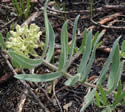 Woolly Milkweed plant
Woolly Milkweed plant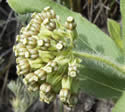 Woolly Milkweed plant
Woolly Milkweed plant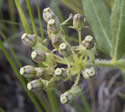 Woolly Milkweed plant
Woolly Milkweed plant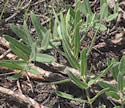 Woolly Milkweed plants
Woolly Milkweed plants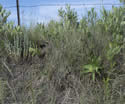 Woolly Milkweed habitat
Woolly Milkweed habitat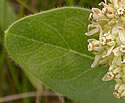 Woolly Milkweed with broader leaves
Woolly Milkweed with broader leaves
Photos by K. Chayka taken in Polk County. Photos by John Thayer taken in Polk County. Photos by Peter M. Dziuk taken at Grey Cloud Dunes SNA, Washington County.
Comments
Have you seen this plant in Minnesota, or have any other comments about it?
on: 2014-08-05 20:15:46
Hi--the SNA in Washington County is the "Grey Cloud Dunes SNA."
Larissa Mottl
Central Region SNA Program Coordinator
on: 2015-04-13 10:08:11
I want to plant milkweed for the butterflies. Thanks
on: 2015-06-21 14:56:49
Found two of these milkweeds in the prairie/hillside areas at Pin Oak SNA
on: 2015-10-30 16:59:28
FYI - This species is not listed as Special Concern in MN (though it should be considered for listing).
on: 2015-10-30 20:14:39
Chris is correct - not Special Concern in MN.
on: 2018-10-14 10:30:50
I've observed this milkweed at a couple sites in Sherburne County, and did observe a single seed pod. Ants may be an important pollinator. -Chris
on: 2019-08-28 20:41:20
There is a good population of this species in the Agassiz Dunes SNA area of Polk county MN, near Fertile MN. I have photos of this plant in fruit and have even collected seed from it. 2019 has been a good year for Asclepias lanuginosa.
on: 2020-07-25 22:14:10
I had 3 or 4 of these blooming along my property in the tall grass between my yard and the road until the city came last week and mowed the whole area down without even letting me know it was going to happen.
on: 2022-10-04 14:55:28
Several woolly milkweed plants were found at the City of Fertile's Fertile Sand Hills Recreation Area site in 2022. As of 10/4/22 most have gone to seed but a couple still have pods. The Fertile site is just north of the Agassiz Dunes SNA noted above by Tyler Janke--part of the same complex.






